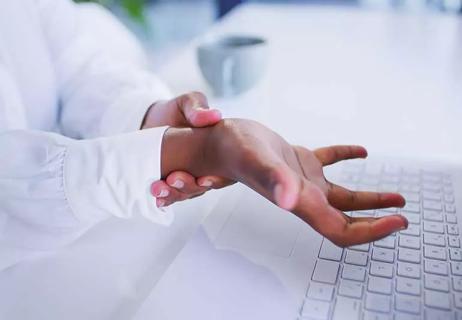7 tricks to try to ease the tingling pain

Does the thumb side of your hand feel like it’s going to sleep — that weak, numb, pins-and-needles feeling — for no apparent reason? You may suspect that you have carpal tunnel syndrome.
Advertisement
Cleveland Clinic is a non-profit academic medical center. Advertising on our site helps support our mission. We do not endorse non-Cleveland Clinic products or services. Policy
The good news is that there are several methods you can try at home to ease your pain. And if those don’t work, surgery can be a highly effective treatment.
For a run-down of the best home remedies for carpal tunnel syndrome, we spoke with orthopedic surgeon William Seitz, MD.
Carpal tunnel syndrome is a fairly common condition that affects your hand and wrist, says Dr. Seitz.
Carpal tunnel syndrome happens when the median nerve, which runs from your forearm to your hand through a narrow space called the carpal tunnel, is compressed or pinched, Dr. Seitz says.
“Symptoms include numbness, tingling and pain, usually in your thumb and the first three fingers of your hand,” Dr. Seitz explains.
Nine tendons that flex the first three fingers and thumb also run through your carpal tunnel. Anything that makes the carpal tunnel smaller — and pinches the median nerve — can result in carpal tunnel syndrome, Dr. Seitz says.
While carpal tunnel syndrome can be uncomfortable or painful, you can treat it at home. The first step to take is to stop the activity that is causing the compression.
“Think about the activities that you think might be causing numbness and pain in your wrist and try to stop or reduce them,” Dr. Seitz says. “You can resume the activity when your symptoms improve.”
Advertisement
Here are five ways you can treat your carpal tunnel syndrome at home.
Ice your wrist or soak it in an ice bath for 10 minutes to 15 minutes once or twice an hour. The cold should help ease the pain, at least temporarily, in your wrist. It also keeps swelling of the affected tendons down.
Buy a wrist splint to keep your hand properly aligned. It may help to wear the splint at night to keep you from flexing or overextending your wrist while you sleep.
Relieve nighttime pain by gently shaking your hand and wrist or hanging your hand over the side of the bed. This can relieve pressure on the median. Other exercises, especially when combined with a splint, can have a similar effect.
Take a nonsteroidal anti-inflammatory drug (NSAID), such as ibuprofen or naproxen to relieve pain. Take NSAIDs with food and after consulting your primary care physician to make sure there are no medical reasons — such as interaction with other medicines you may be taking — to avoid these pain relievers.
Immerse your hand in warm water — with a temperature between 92 degrees Fahrenheit and 100 degrees Fahrenheit (33 degrees Celsius and 37 degrees Celsius) — and gently move or flex your hand and wrist. Do this three to four times a day.
You can also try some changes to your work environment if you do a lot of sitting and typing at a desk, including:
These changes can help take pressure off your median nerve and tendons, providing at least temporary relief.
Injections of corticosteroids – a type of anti-inflammatory drug – can bring pain relief to those with carpal tunnel syndrome. Just as with other treatments, cortisone shots reduce inflammation of the tendons around the median nerve, easing pain.
If these home treatments don’t ease your pain in one or two weeks, it might be time to see an orthopedic physician, who specializes in the treatment of bones, joints and muscles. More intensive treatments might be suggested and your healthcare provider may also look for other conditions that can be affected by carpal tunnel syndrome.
A recent study on which Dr. Seitz worked found that patients with carpal tunnel syndrome who may also have amyloidosis, a protein disorder, could be at risk for congestive heart failure. In this case, a biopsy can be performed during carpal tunnel surgery to test for amyloidosis.
“Your healthcare provider may recommend surgery if there’s severe damage to your median nerve or to prevent permanent sensory or functional loss,” Dr. Seitz says.
Advertisement
Surgery for carpal tunnel syndrome involves cutting the ligament at the base of your palm that covers the carpal tunnel. This procedure increases the size of the carpel tunnel, taking pressure off both your median nerve and your tendons.
“Over time, surgery may be the best route to permanent relief,” Dr. Seitz says.
Advertisement
Learn more about our editorial process.
Advertisement

These movements can help with pain, numbness and tingling in your hands and fingers

After knee arthroplasty, swelling-related pain is common, but infection and blood clots are also risks

Hanging upside down for any length of time may decompress the tension in your spine

These creams that you apply to your skin can actually help reduce localized pain, swelling and inflammation

If soaking your feet, disinfecting your shoes and making lifestyle changes don’t do the job, it’s time to talk to a doctor

Genetics, hormones, medications and stress are just a few reasons your feet could be extra funky

Research doesn’t show any benefits to wearing copper bracelets — but your experience may vary

Your choice depends on your reason and need for treatment

Start having sex about 72 hours before ovulation, then at least every other day during your fertile window

Attachment theory suggests that your earliest relationships shape connections throughout your life

It isn’t a recognized mental health disorder, but research shows that problematic social media use can negatively affect your mental health, self-esteem and sleep